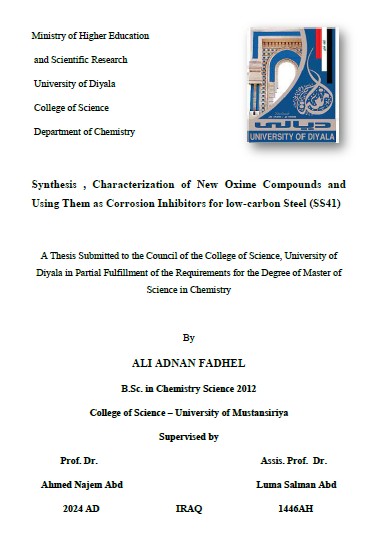Abstract
Inhibition is an important process in decreasing corrosion in the low-carbon steel alloys.
In this study, various organic compounds were synthesized (4-(dimethylamino)benzaldoxime , 2-amino-5-chloro benzophenoxime , 4-( Dimethylamino)benzaldehyde-2,4-Dinitrophenyl hydrazone , 2-amino-5- chloro benzophenone-2,4 Dinitrophenyl hydrazone , 4-(Dimethylamino)benzonitrile and { [ ( 2-benzoyl-5-chlorophenyl ) imino ] methyl } – N,N-dimethyl aniline ) and used oxime compounds to protect low-carbon steel (SS41) alloy in a 0.5 M H2SO4 solution at temperatures of (25, 35, 45, and 55) and concentrations (50, 100, 150, 200, 250, and 300) ppm of synthesize compounds which were utilized. Corrosion tests, inhibited surface analysis and other thermodynamic techniques were used to evaluate the inhibition process. FT-IR, 1HNMR and 13CNMR were used to characterize the prepared compounds.
The corrosion test (weight loss measurement) showed high inhibition efficiency (IE%) at 55°C and 300 ppm in 0.5 M H2SO4, for 4-(dimethylamino)benzaldoxime being 91.72%, while for 2-amino-5-chloro benzophenoxime being 87.77%.
The adsorption behavior of inhibitors has been studied using three adsorption isotherms. Adsorption isotherms include the Langmuir, Freundlich, and Temkin isotherms. It has been shown that it applies to the Langmuir adsorption isotherm. To determine the type of adsorption, from the values of activation energy and the enthalpy of activation adsorption it was found be physical adsorption.
SEM images of the inhibited surface showed that the chemical molecules were adsorbed on the low-carbon steel (SS41) surface resulting in inhibition and AFM images pointed out the roughness of surfaces.





